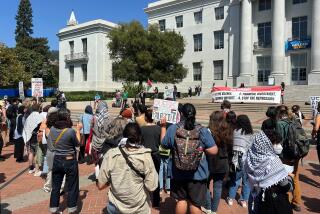CSU Officially Retreats From Taylor Ranch : Negotiations: An influential university panel recommends reopening the search for a suitable location for a new campus. Approval would delay construction of a facility by years.
- Share via
Citing the likelihood of a lengthy court battle, California State University officially retreated Monday from what was once an all-or-nothing ultimatum that the controversial Taylor Ranch site west of Ventura is the only acceptable location in the county for a new university campus.
Ellis E. McCune, acting chancellor of the university system, said the key factor in the university’s retreat from its once-tough insistence on the Taylor Ranch site was the threat of a years-long court battle by the owners of the ranch.
A lack of unified community support, division within the Ventura City Council over the Taylor Ranch site and the anticipated cost of freeway access to the hillside site were other factors in a decision to completely reopen the site selection process, McCune said.
The university’s quiet retreat from its earlier position came just one month after Cal State Chancellor W. Ann Reynolds, who had issued the Taylor Ranch ultimatum last December, was forced from office, but university officials said the policy change had nothing to do with her ouster.
“The decision by the owners that they would not sell their property without a full condemnation procedure, coupled with all the other factors, makes this a very difficult project,” McCune said. “It’s problematical whether we could ever proceed.”
The decision Monday to reopen site selection--a process expected to delay construction of any new campus in the county by years--was made during a meeting at the office of the chancellor in Long Beach by an ad-hoc committee of trustees charged with finding a campus location.
The full board is expected to approve the recommendation when it meets next month, said university Vice Chancellor John M. Smart. The mechanics of literally starting over again will be determined by an advisory committee--made up of representatives from cities and county staffs as well as advocates and opponents of the Taylor Ranch site--that will meet in Ventura on July 13.
At that time, the committee will decide how to evaluate sites, Smart said. He said the university will examine sites already proposed as well as new locations never before considered. The committee will then narrow the choices down and present its recommendations to a consultant who will perform the necessary environmental impact studies.
While university officials say the ultimate site for a new campus is now wide open, a parcel of farmland at Rice Avenue and the Ventura Freeway in Oxnard is one location that is being discussed as a possible option. Another location at Rose and Central avenues west of Camarillo has also been discussed.
Some Taylor Ranch supporters, including Ventura City Councilman James Monahan, took Monday’s dramatic shift by Cal State as a sign that the university may never build a campus in Ventura County.
“It’s the beginning of the end,” Monahan said.
But university officials stressed on Monday that their commitment to Ventura County is strong.
“We feel the need is there,” Trustee Marian Bagdasarian said.
The university chose the 465-acre hillside Taylor Ranch west of Ventura as its preferred location in 1987, after negotiations fell apart for its first choice, land owned by the Lusk Co. near Ventura Harbor.
Taylor Ranch heiress Cynthia Wood, her mother and stepfather had previously agreed to what Cal State officials called a friendly condemnation, in which they agreed to sell their property under the threat that the state would condemn it.
That would have allowed the property owners a tax advantage while avoiding the need for lengthy court action to take the property against the owners’ wishes.
But on May 22, the owners cut off negotiations with the university, officials said. Through their attorney, James Hurley, the owners insisted that they would fight the state in court to keep their property.
Hurley did not return calls on Monday to explain the owners’ change of heart.
“No one is more disappointed than we are with this,” said Smart, a Santa Barbara native who was raised in Ventura.
Although the Taylor Ranch site will still be included in the environmental impact study, it will no longer be the focus of the report, officials said. Officials said they will consider sites with a minimum of 200 acres, with good freeway access, single ownership and little or no community opposition.
The reopening of the site selection process will make it impossible to meet a four-year target date to open a two-year off-campus center, the first phase of a campus that would grow over 30 years into a four-year university serving up to 15,000 students, Smart said.
He could not project a new date for a university in Ventura County, saying only he hopes that it will be “before the turn of the century.”
The decision to pull back from the Taylor Ranch site has already had immediate effects on the center here, known as the Ventura campus of Cal State Northridge, said Smart and campus Director Joyce M. Kennedy.
“Our enrollment curve has already been adjusted,” Kennedy said. “We had been approved to grow from 125 to 150 full-time equivalent students. That has been cut back to 80.”
That campus, now located in rented space near Seaward Avenue and the Ventura Freeway in Ventura, is bursting at the seams with no more room to grow and a long student waiting list, Kennedy said. Monday’s decision, the culmination of events occurring over the past three months, means that the campus will have to survive longer in leased facilities.
Russ Baggerly, executive director of the Environmental Coalition and an outspoken opponent of the Taylor Ranch, said Monday that the county can become unified in a search for an appropriate university site.
“If they had continued with the Taylor Ranch, it would have killed all the opportunity for a university in Ventura County,” Baggerly said of university officials. “Now, the opportunities are very bright for finding a site.”
Cal State performed its first environmental impact report on Taylor Ranch in 1987, projecting a two-year campus with about 2,000 students. Baggerly and the Environmental Coalition filed a lawsuit challenging that study, contending that the ultimate size of the campus should be considered.
In a major turning point in the fight against the Taylor Ranch site, Superior Court Judge Joe Hadden ruled against the state last November, saying it had to prepare a second environmental impact report based on the ultimate establishment of a four-year campus.
As opposition mounted from environmentalists fearing additional air pollution from students’ cars and traffic in downtown Ventura, then-Chancellor Reynolds told the county that she was not sure whether the state would go through with a second expensive environmental impact report if there was not the necessary community support.
In December, she told Ventura County that the state would no longer consider alternative sites. It was Taylor Ranch or nothing, she said. Supporters in the community rallied, and trustees decided to order a second impact report on March 1. By law, an environmental impact report must also consider alternate sites, but university officials stressed that their focus was the Taylor Ranch.
Reynolds has since left the university system under pressure for reasons unrelated to Taylor Ranch. She is technically still on the staff until July 1 but has been replaced in her duties by McCune. Smart said her departure is unrelated to the trustees’ reopening of the site selection.
More to Read
Sign up for Essential California
The most important California stories and recommendations in your inbox every morning.
You may occasionally receive promotional content from the Los Angeles Times.










